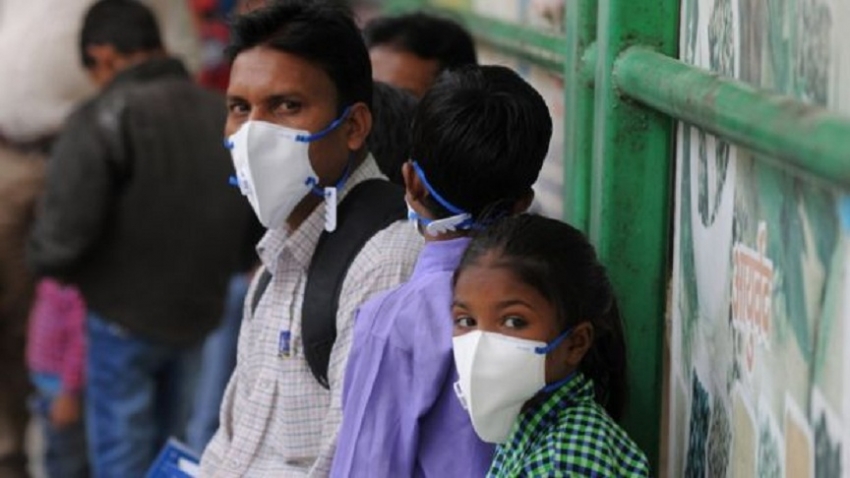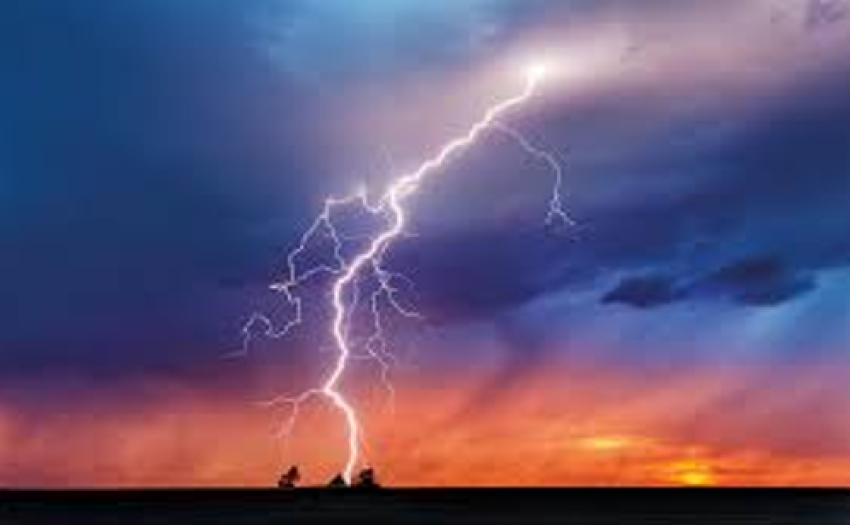Five million masks are being distributed at schools in India's capital, Delhi, after pollution made the air so toxic officials were forced to declare a public health emergency.A Supreme Court-mandated panel imposed several restrictions in the city and two neighbouring states, as air quality deteriorated to "severe" levels.Dangerous particulate levels in the air are about 20 times the WHO maximum.The city's schools have also been closed until at least next Tuesday.All construction has been halted for a week and fireworks have been banned. From Monday, the city will introduce a temporary scheme so that only cars with odd or even numbered licence plates can drive on given days, in a bid to cut traffic pollution.Delhi's Chief Minister Arvind Kejriwal said the city had been turned into a "gas chamber".
It is very imp that we protect ourselves from this toxic air. Through pvt & govt schools, we have started distributing 50 lakh masks todaI urge all Delhiites to use them whenever needed The masks are being handed out to students and their parents, and Mr Kejriwal has asked people to use them as much as possible. The levels of tiny particulate matter (known as PM2.5) that enter deep into the lungs are 533 micrograms per cubic metre in the city. The World Health Organization (WHO) recommends that the PM2.5 levels should not be more than 25 micrograms per cubic metre on average in 24 hours.
As thick white smog blanketed the city, residents started tweeting pictures of their surroundings.Photos of German leader Angela Merkel's official visit showed the obscuring effect of the smog at the presidential palace - though both leaders ignored the declared public health emergency and declined to wear masks.The German and Indian leaders met at India's presidential palace amid the smogSome workers were being told to work from home to avoid the pollution.One account director at market research firm Kantar, which employs several hundred people in the city, told Reuters staff had been told not to come in on Monday.Many local residents are furious that the situation remains the same year after year. Municipal workers and vulnerable groups have been given thousands of free high-grade N95 masks in recent years.
Two years ago this month, hospital patients in Gurgaon were issued masks amid similar conditions
"I didn't realise how bad it would get," one resident said. "Do we really want our kids to grow up in such an environment? No-one really cares, no-one wants to improve the situation."The hashtags #DelhiAirQuality and
The thick smog also raised concerns for the weekend's cricket clash between India and Bangladesh. A 2017 match in similar polluted conditions led to Sri Lankan players vomiting on the pitch.But Bangladesh's coach said that despite "scratchy eyes" and sore throats among his players, the game would go ahead.Bangladesh head coach Russell Domingo (R) wore a mask to training, but said his players would get on with it "No-one is dying," Russell Domingo told the Press Trust of India. "Look, there's a bit of pollution in Bangladesh as well, so it's a not a massive shock unlike some other countries. The players have just got on with the game and haven't complained too much about it," he said.
Why is the pollution so bad?One of the main reasons for air quality in the city worsening every year in November and December is that farmers in the neighbouring states of Punjab and Haryana burn crop stubble to clear their fields. It's made worse by the fireworks during the Hindu festival of Diwali.There are other reasons too, including construction dust, factory and vehicular emissions, but farm fires remain the biggest culprit.More than two million farmers burn 23 million tonnes of crop residue on some 80,000 sq km of farmland in northern India every winter.The stubble smoke is a lethal cocktail of particulate matter, carbon dioxide, nitrogen dioxide and sulphur dioxide.
Using satellite data, Harvard University researchers estimated that nearly half of Delhi's air pollution between 2012 and 2016 was due to stubble burning.The burning is so widespread that it even shows up in satellite photos from Nasa.
What are PM 2.5 particles? Particulate matter, or PM, 2.5 is a type of pollution involving fine particles less than 2.5 microns (0.0025mm) in diameter A second type, PM 10, is of coarser particles with a diameter of up to 10 microns
Some occur naturally - e.g. from dust storms and forest fires, others from human industrial processes
They often consist of fragments that are small enough to reach the lungs or, in the smallest cases, to cross into the bloodstream as well
Delhi smog: Foul air came from India's farming revolution
Soutik Biswas
India correspondent
23 October 2018
Share this with Facebook Share this with Messenger Share this with Twitter Share this with Email Share
Image copyrightAFP
Image caption
Many participants in the Delhi half marathon on Sunday wore anti-pollution masks
If there was a gold medal for bad air, Delhi would be hard to beat.
Yet, despite high levels of air pollution, more than 30,000 people, many wearing masks, took part in the capital's half marathon on Sunday. Organisers said they used devices on the route to transmit radio frequency waves to clear the air, but scientists were sceptical of these claims.
Delhi's marathon, ironically, marked the beginning of the city's smog season. But it has been creeping up on the capital for a few weeks now.
A fortnight ago, Nagendar Sharma was returning to Delhi from the hill station city of Shimla when he spotted smoke rising from the farms alongside the highway.
Bryan Adams photo shows Delhi gig pollution
Hair-raising drive through Delhi smog
Delhi trials smog-blasting cannon
It looked like someone had picked up a box of matches and set the earth on fire. Lack of winds meant that the acrid smoke hung in the air.
Mr Sharma, the Delhi-based media adviser to the capital's chief minister, was driving through Haryana, barely 70km (43 miles) from the capital.
When he stopped his vehicle to investigate he found that the farmers had begun to burn the stubble left over from harvesting rice. They said they had to remove the residue in three weeks to prepare the farms to sow wheat. They were burning the crop stubble as they could not afford the expensive machines that would remove them.
"It's the same old story. Every year," Mr Sharma said.
Every year, around this time, residents of Delhi wake up to a blanket of thick, grey smog. Pollution levels reach several times the World Health Organisation's recommended limit. Last year, doctors declared a state of "medical emergency"; and hospitals were clogged with wheezing men, women and children.
Image copyrightEPA
Levels of tiny particulate matter (known as PM 2.5) that enter deep into the lungs reached as high as 700 micrograms per cubic metre in some areas. The WHO recommends that the PM2.5 levels should not be more than 25 micrograms per cubic metre on average in 24 hours.
Last winter Air Quality Index (AQI) recordings consistently hit the maximum of 999 - exposure to such toxic air is akin to smoking more than two packs of cigarettes a day. The city becomes what many call a "gas chamber".
"This marks the beginning of the Great Smog that goes on to last for about three months, even though the crop residue burning lasts a few weeks. It is during this period that air quality indices hit their maximum possible limits, when visibility drops drastically, when regions even far away - such as Delhi - smell of burning gas," says Siddharth Singh, energy expert and author of a book soon to be published, The Great Smog of India.
And although there are other reasons - construction dust, factory and vehicular emissions - it's mainly crop residue that has emerged as one of the main triggers for the smog.
More than two million farmers burn 23 million tonnes of crop residue on some 80,000 sq km of farmland in northern India every winter.
The stubble smoke is a lethal cocktail of particulate matter, carbon dioxide, nitrogen dioxide and sulphur dioxide. Using satellite data, Harvard University researchers estimated that nearly half of Delhi's air pollution between 2012 and 2016 was due to stubble burning. Another study attributed more than 40,000 premature deaths in 2011 to air pollution arising from crop residue burning alone.
But it wasn't always like this.
Image copyrightREUTERS
Image caption
The smoke from the burning fields contains toxic gases
In Mr Singh's telling, the deadly pea-souper is result of the "evolution of the farming operations, government policy and changing labour markets" sparked by the "green revolution" in India in the late 1960s and 1970s.
The "green revolution" allowed a country wracked by famines, hobbled by un-irrigated farms and dependency on food aid to produce enough grain to feed its people. The northern states of Punjab and Haryana turned into breadbaskets, producing enough rice and wheat for the country. Wheat is sown and harvested during winters, and rice to coincide with the monsoon season in July and August.
Price support for crops, high-yielding seeds, expanded irrigation, official farming timetables and the introduction of combine harvesters - which combined the jobs of cutting and threshing the crop in order to produce processed grain in a matter of seconds - were the catalysts of this modern farming revolution.
The "green revolution" was an unqualified success in giving India much-needed food security. It led to vast increases in wheat and rice production, but also ended up polluting air and depleting groundwater.
"That a revolution in agriculture was necessary is by itself not up for debate. What the revolution and the subsequent policies did, however, was contribute to the creation and timing of the air pollution crisis and also to the rapidly depleting groundwater levels; this has been termed as an 'agro-ecological' crisis," says Mr Singh.
Farmers burn crop residue because the stubble left behind after the combine harvesters have done their job is sharper and taller than it otherwise would be, potentially injurious to farmers and not good fodder for animals. If they do not remove the stubble, straw gets stuck in the machines that plant the rice crop.
Image copyrightREUTERS
Image caption
The smoke remains in the air, causing severe health issues for people
So they simply set fire to the farmland to get the soil ready quickly for the next crop, as Mr Sharma saw on the highway to Delhi.
According to Siddharth Singh, there are some 26,000 combine harvesters in use in India, most of them in northern India. They are responsible for a practice that is now a major contributor to air pollution.
The government has tried to solve this with "happy seeders", which are attachments mounted on tractors that help plant wheat seeds without getting jammed by rice straw stubble from the previous crop. But they are expensive - upwards of 130,000 rupees (£1,363; $1,769) and diesel-guzzlers - and remain out of reach for most farmers, who own small plots of land.
During the smog season last year, according to Mr Singh, there were about 2,150 of these machines in Punjab and Haryana as against an estimated requirement of more than 21,000. Another machine called the "super straw management system" which chops and spreads the stubble evenly is also effective but expensive for the majority of farmers.
Mr Singh reckons if crop stubble burning is to be stopped fully within five years, 12,000 "happy seeders" will need to be purchased every year. India, he believes, needs a second "green revolution which would be a technological one - one that adequately deals with agricultural shock to air quality". Until that happens, Delhi's foul air will continue to poison its 18 million people.
Tackling pollution from stubble burning in India
Pollution from burning fields makes the already bad pollution problem even worse
Stubble burning is an event that dominated my childhood.When you lived in the countryside in the 1970s it was common for farmers to set fields of straw ablaze and living in a thatched cottage it was a nerve wracking time.I have vivid memories of fire engines racing through the village and the sky darkening with smoke and soot.Well we don't stubble burn in this country anymore, farmers plough the straw into the earth instead, but in India it's still a common practice.
This is the Pyroformer at work in India turning straw into oil and fertilizer
Every year much of the Punjab is torched and smoke plumes up into the sky. Satellite photos from NASA show the smoke from thousands of burning fields drifting down towards Delhi where it adds to the already terrible problems of pollution in the city.
I've been in Delhi in the burning season and the air is thick and acrid and it is very difficult to breathe.
Income from straw
Indian farmers have good reason to burn their straw after harvest. They want to get the next crop in quickly and the straw itself has no value. It's also local farming wisdom that burning gets rid of pests and weeds.
Now researchers from Aston University are in India trying to change all this. Aiming to provide Punjabi farmers with an income from straw that should stop the burning and reduce the pollution.
Burning fields is still a common way for farmers in the Punjab to prepare the ground for the next crop
It's all based around a technique called intermediate pyrolysis. You take a waste product, in this case the straw, and burn it under very controlled conditions in something called a Pyroformer. The end result is an oil that can be used to power generators and pellets that can be used as fertilizer.
Aston University believe this project could halt the burning of 116m metric tonnes of crop residue in the Punjab by turning a waste product into something that has value. They are now working with Indian agricultural institutions to show how the technology works and the benefits to farmers.
It's early days but next year the team hope to have 20 to 40 plants in place tackling a few thousand acres of straw.For someone who remembers the pollution and stress stubble burning inflicted on my family every year stopping it happening at all will bring huge benefits to the people of the Punjab.




















